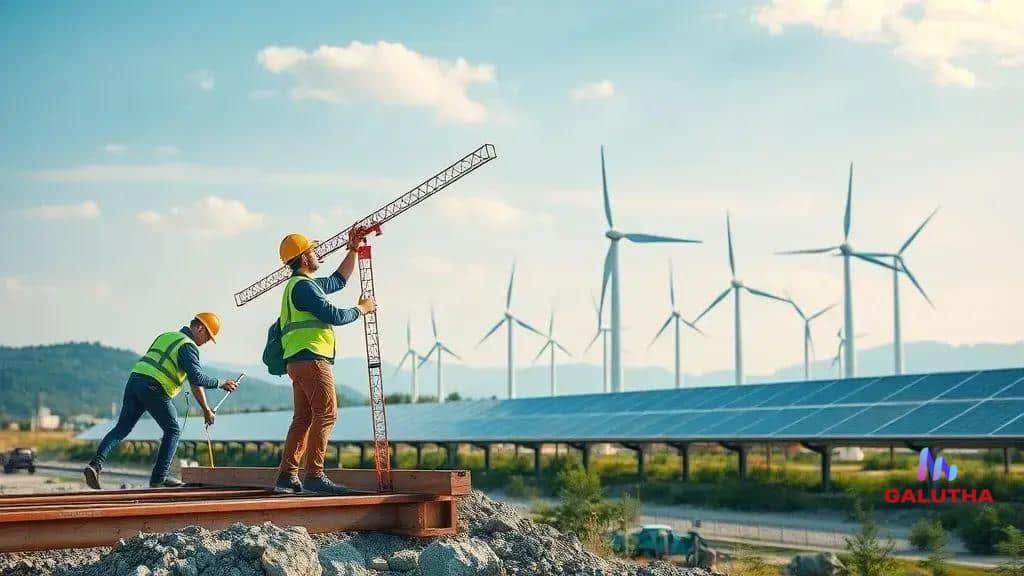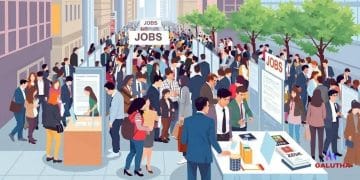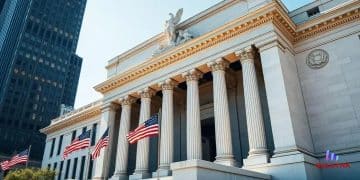Biden economic plan: what it means for everyday Americans

The Biden economic plan focuses on job creation, support for small businesses, and addressing inflation through investment in infrastructure and green energy, aiming to build a sustainable and robust economy for all Americans.
The Biden economic plan aims to reshape the U.S. economy in numerous ways. But how does this affect your daily life? Let’s explore its main aspects and potential impacts.
Understanding the Biden economic plan
Understanding the Biden economic plan is essential to grasp how the government intends to address key issues affecting Americans today. This plan encompasses various economic initiatives that aim to stimulate growth and improve living standards.
Key Components of the Plan
The Biden economic plan focuses on several vital areas to revitalize the economy. These include:
- Infrastructure Investment: Increasing funding for roads, bridges, and public transportation.
- Green Energy Initiatives: Promoting sustainable energy sources to combat climate change.
- Healthcare Accessibility: Expanding access to affordable healthcare for all citizens.
- Tax Reforms: Ensuring that wealthier individuals contribute fairly to the economy.
Each of these components plays a critical role in shaping the economic landscape. For example, by enhancing infrastructure, the government aims to create jobs and improve efficiency in transportation.
Economic Goals
Another significant aspect of the plan is to tackle economic inequality. The administration seeks to level the playing field by prioritizing resources for underserved communities. This approach not only fosters growth but also ensures that everyone benefits from economic progress.
Moreover, by investing in green energy, the Biden administration envisions a more sustainable future. This transition to renewable energy sources could lead to millions of jobs in new industries.
Healthcare accessibility is also a major focus, emphasizing that a healthier population contributes to a stronger economy. When people can access healthcare, they are more productive and less likely to face financial ruin due to medical expenses.
Key initiatives and their importance

Key initiatives in the Biden economic plan are designed to create meaningful change in the lives of Americans. These initiatives focus on areas that will greatly impact the economy and society.
Infrastructure Improvements
Investing in infrastructure is a cornerstone of the plan. Improved roads, bridges, and public transportation systems are crucial for enhancing daily commutes and boosting commerce. A reliable infrastructure creates more jobs and supports local businesses.
- Job creation: Infrastructure projects often lead to thousands of new jobs.
- Economic growth: Better transportation networks facilitate trade.
- Public safety: Upgraded roads and bridges reduce accidents.
Such enhancements ensure that the economy runs smoothly, benefiting everyone from workers to businesses.
Green Energy Transition
Another vital initiative is the transition to green energy. This involves investing in renewable energy sources like solar and wind power. By promoting cleaner energy, the government aims to combat climate change while also creating a sustainable workforce.
Transitioning to renewable energy not only helps the environment but also positions the U.S. as a leader in global energy innovation. This shift encourages economic growth in new sectors, supporting jobs that are crucial for the future.
Healthcare initiatives are also a significant part of the economic plan. By expanding healthcare accessibility, the government aims to reduce financial burdens on families. When individuals can afford healthcare, they can contribute more effectively to the economy.
Each initiative is interconnected, emphasizing that investments in one area can lead to improvements in another. As these initiatives unfold, they will shape a better economic future for all Americans.
How the plan addresses inflation
Understanding how the Biden economic plan addresses inflation is crucial for navigating the current economic climate. Inflation affects everything, from the prices of groceries to the cost of housing.
Monetary Policy Measures
The plan includes monetary policy measures designed to stabilize prices. The Federal Reserve plays a key role in managing interest rates to control inflation. Lowering interest rates can encourage spending and investment, while raising them can help cool off an overheating economy.
- Interest rate adjustments: These are used to manage inflation effectively.
- Bond buying programs: The Fed purchases bonds to inject money into the economy.
- Monitoring economic indicators: Keeping track of inflation rates helps guide policy decisions.
These strategies can help manage inflation while still encouraging economic growth.
Investment in Supply Chain Solutions
Another vital aspect of addressing inflation is improving supply chain efficiency. Delays in supply chains can lead to higher prices for goods. By investing in infrastructure and technology, the Biden plan aims to streamline production and distribution processes.
Enhancing the supply chain can significantly reduce costs for businesses. Streamlined operations lead to lower prices for consumers, which helps combat inflation. When products are available more readily, prices stabilize, benefiting everyone in the economy.
Additionally, the plan emphasizes supporting local businesses. By assisting small to medium enterprises, the government aims to enhance competition in the marketplace. More competition often leads to better prices and services, further addressing inflationary pressures.
As the plan unfolds, its impact on inflation will be closely monitored to ensure that the economy remains healthy and stable for all.
The impact on job creation

The Biden economic plan places significant emphasis on job creation as a pathway to economic recovery. By investing in various sectors, the plan aims to provide millions of job opportunities to Americans.
Focus on Infrastructure Projects
One of the main ways the plan will create jobs is through extensive infrastructure projects. Upgrading roads, bridges, and public transportation systems not only enhances efficiency but also creates numerous jobs for construction workers and engineers.
- Job diversity: Infrastructure improvements demand a range of skills from various fields.
- Long-term employment: Many of these jobs will be permanent or for the duration of multi-year projects.
- Community impact: Local economies will benefit from job creation in their areas.
By focusing on these projects, the administration anticipates a significant boost in employment across the country.
Investment in Green Technology
Additionally, the push for green technology is central to the job creation strategy. The shift to renewable energy sources will require a workforce skilled in new technologies. This transition not only aims to combat climate change but also creates several job opportunities in sustainable industries.
Jobs in solar, wind, and other renewable sectors are expected to increase rapidly. Companies will need workers in roles ranging from engineering to installation and maintenance, providing ample opportunities for those entering the workforce or seeking to reskill.
Supporting small and medium-sized businesses is another vital element of the economic plan. By offering grants and incentives to these businesses, the administration supports job creation at the local level. Healthy small businesses lead to a vibrant economy with job opportunities for local residents.
As the Biden economic plan unfolds, its focus on job creation will be crucial for changing the lives of many families across the nation, allowing people to secure stable employment and build a better future.
What it means for small businesses
The Biden economic plan holds significant implications for small businesses across the nation. By prioritizing support for these enterprises, the plan aims to create a more vibrant and equitable economy.
Access to Funding
One major outcome of the plan is improving access to funding for small businesses. With increased grants and low-interest loans available, entrepreneurs have more opportunities to start or expand their businesses. This financial support is crucial, especially for minority-owned enterprises that often face challenges in securing capital.
- Grants and loans: Easier access to financial resources allows for business growth.
- COVID-19 recovery funds: Specific funds are available to help small businesses recover from the pandemic.
- Investment in technology: Funding can also support technological upgrades to improve efficiency.
With these resources, small businesses can thrive and compete more effectively in the market.
Regulatory Relief
Another critical aspect is the plan’s focus on reducing regulatory burdens for small businesses. Streamlined processes make it easier for entrepreneurs to navigate the necessary legal requirements, saving both time and money. Simplifying regulations allows business owners to focus more on their operations rather than getting bogged down in red tape.
Moreover, this plan emphasizes the importance of equitable trade policies. By creating fair opportunities in trade, small businesses can access new markets and grow their customer base. This approach helps ensure that smaller enterprises can compete globally, benefiting the economy as a whole.
Overall, the Biden economic plan aims to foster an environment where small businesses can thrive, leading to job creation and economic growth. As these businesses expand, they contribute to local economies, providing essential services and products to communities.
The Biden economic plan focuses on creating jobs, supporting small businesses, and addressing inflation. Through investments in infrastructure and green energy, it aims to revitalize the economy and provide opportunities for all Americans. By easing access to funding and reducing regulatory burdens, the plan empowers small businesses to thrive. This holistic approach promotes not only economic growth but also a sustainable future, ensuring that every citizen can benefit from a stronger economy.
FAQ – Frequently Asked Questions about the Biden Economic Plan
How does the Biden economic plan create jobs?
The plan creates jobs by investing in infrastructure projects and promoting green energy initiatives, which require a skilled workforce.
What support is available for small businesses?
The plan offers increased access to funding, grants, and reduced regulatory burdens to help small businesses grow and thrive.
How does the plan address inflation?
It addresses inflation through monetary policy measures, improving supply chain efficiency, and monitoring economic indicators.
What are the benefits of investing in green energy?
Investing in green energy creates sustainable jobs, helps combat climate change, and positions the U.S. as a leader in energy innovation.





